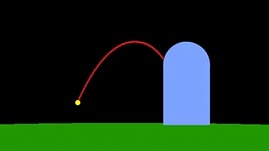Teachers' Domain - Digital Media for the Classroom and Professional Development
User: Preview

Source: NASA/JPL-Caltech
The Moon, Earth's natural satellite, seems to hover in the sky, unaffected by gravity. However, the reason the Moon stays in orbit is precisely because of gravity -- a universal force that attracts objects. With the right combination of speed and gravity, satellites can fall around, instead of into, the body that they orbit. In this animated video segment adapted from NASA, learn about how the Moon stays in orbit around Earth.
Why Doesn't the Moon Fall Down? (Audio Description) (Video)
The solar system is full of satellites. Earth has many satellites, including the natural Moon as well as artificial satellites placed in orbit for scientific research, communication, and navigation purposes. Other planets have their own moons and artificial satellites, too. Earth itself is a satellite of the Sun, as are each of the other planets in our solar system. Still, despite the many different kinds of satellites, the physical force that keeps all satellites in orbit is the same -- gravity.
Gravity is an attractive force between any objects with mass. When an object that is not supported by anything falls due to the force of gravity of another object, it is said to be in free fall. An orbit is essentially a path of constant free fall. For example, the Moon is falling towards Earth. However, it also has an orbital speed from the momentum gained during its formation that allows it to fall around Earth with a trajectory that follows the same curve as Earth's surface. Because these paths are parallel, the Moon perpetually falls around Earth without ever touching it.
In our solar system, the time it takes each planet to complete an orbit around the Sun varies greatly. Inner planets have much shorter orbits - in distance and in time -- than outer planets. For example, Mercury, the closest planet to the Sun, completes an orbit around the Sun in 88 days, while Earth takes one year to make a complete orbit. Pluto, whose average distance from the Sun is about 40 times greater than Earth's, takes 248 years to complete its orbit.
In addition, outer planets also take a long time to orbit the Sun because they have slower average orbital speeds than inner planets. Closer to the Sun, the pull of gravity is very strong, so a planet needs a lot of speed to stay in orbit. If the planet does not move fast enough, gravity would cause it to fall into the Sun. In general, the stronger the force of gravity, the more speed is needed to keep the planet falling around, instead of into, the object it is orbiting. Because the force of gravity weakens with distance, there is less gravity farther away from the Sun, so less speed is needed to keep an object in orbit. Mercury has an average orbital speed of 48 km/s, whereas Earth's average orbital speed is 30 km/s and Pluto's average orbital speed is only 4.7 km/s.
 Loading Standards
Loading Standards Teachers' Domain is proud to be a Pathways portal to the National Science Digital Library.
Teachers' Domain is proud to be a Pathways portal to the National Science Digital Library.
